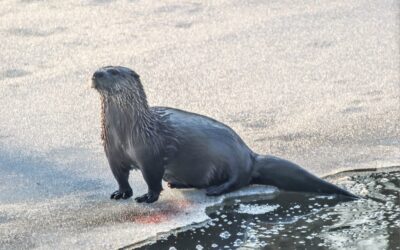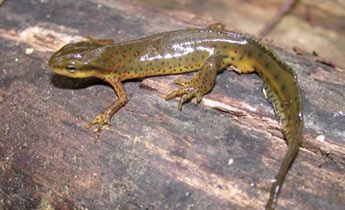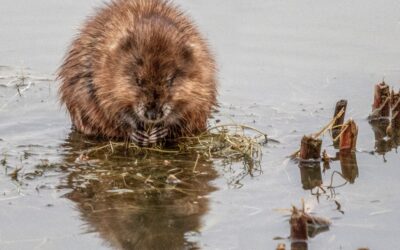Meet our newest guest blogger, Sue Norris. A retired RN originally from the UK, she has lived in the Finger Lakes Region since 1993 and loves the area for its natural beauty, diversity of life and tranquility. Working to be self-sufficient, she grows many of her own veggies, keep a large flock of chickens and heats her home with her own wood, so we can say Sue stays pretty active through the year. Her natural curiosity about animals is a personal education she is eager to share with all, so let’s hop on in to this new series about the smallest critters of the Finger Lakes Region! This month, Sue shares facts and fun about the chipmunk. Stay connected for more intriguing blog posts coming soon!
Name a furry little creature that we all find adorable until it starts eating our veggie and flower plants – if you said chipmunk you are spot on!
Chipmunks are in the squirrel family and so are related not only to squirrels but also woodchucks and prairie dogs. They are typically 4-7 inches long, but a whopping 11 inches has been recorded.
There are several different types of chipmunk – this article talks about the eastern chipmunk (tamias striatus).
These high energy, striped mammals are fascinating to watch as they scamper up trees, down burrows and through the grass. The coloring of their fur helps to disguise them on the forest floor – an overall mid-brown with distinctive black and white “racing” stripes running from head to tail. They are extremely fast on their feet and rarely stray too far from home.
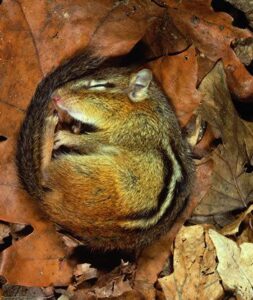 FUN FACT: Chipmunks can sleep up to 15 hours a day!
FUN FACT: Chipmunks can sleep up to 15 hours a day!
Although you may see several together, they really are not social creatures until the breeding season arrives. The mating season runs from early spring to late summer with the female usually producing two litters of 4 to 8 pups (or kittens) after a gestation of 30 days.
These youngsters are born blind and helpless, but will emerge from the burrow around 6 short weeks of age and after a couple of weeks getting the hang of life, they are on their own.
When fall is in the air, chipmunks will start to stockpile food to sustain them through the winter months. You can see them racing around, stuffing those cheek pouches as full as possible before stashing the food in their burrow where they have easy access to it.
FUN FACT: They can gather up to 165 acorns in one day! 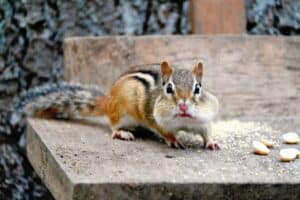
Burrows can be extensive – they have been found to extend from 10 – 30 feet in length! They will have several tunnels in the complex and some have specific uses. Food will be stored in some and detritus from nuts, seeds etc. will be put in the trash tunnel along with their feces. Another area for the females will be the nursery area.
They do partially hibernate, waking a few times through the winter to snack and then sleep again. During this period, their heart rate will plunge from 350 beats per minute, to around 4! Their temperature will drop from 94F down to a cool 40F.
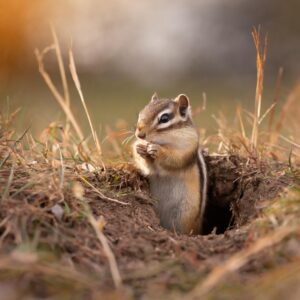 Although we may think of them as vegetarians, they are omnivores and will eat worms, small frogs, insects, and newly hatched birds. They are very partial to cultivated plants – as many gardeners will tell you! They eat a wide variety of seeds, nuts, fruits, and buds and can always be spotted sitting under the bird feeders and my tomato plants!
Although we may think of them as vegetarians, they are omnivores and will eat worms, small frogs, insects, and newly hatched birds. They are very partial to cultivated plants – as many gardeners will tell you! They eat a wide variety of seeds, nuts, fruits, and buds and can always be spotted sitting under the bird feeders and my tomato plants!
Despite their somewhat destructive traits, they are invaluable for planting seeds and dispersing fungal spores upon which they have dined, helping to ensure the diversity of the landscape for years to come. They are very adaptable to circumstances and as such are not considered endangered in the eastern United States. Love them or hate them, they are certainly charming and memorable little creatures.
To learn more about chipmunks, check out these resources:
- https://www.livescience.com/51139-chipmunks.html
- https://www.britannica.com/animal/chipmunk
- https://www.esf.edu/aec/adks/mammals/chipmunk.php
For more fun small critter stories, check out the other blog posts on the SFLM website!

